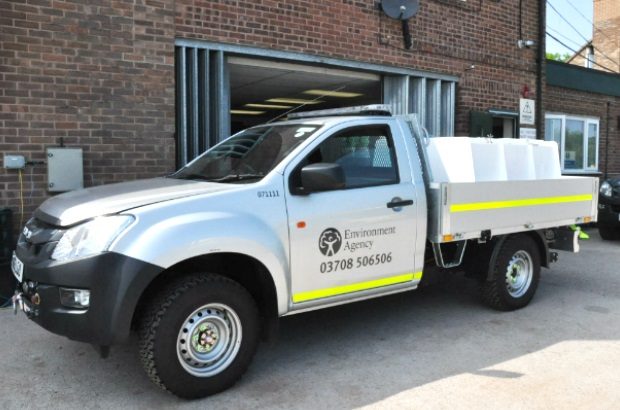This blog originally appeared on the Countryfile Magazine website: http://www.countryfile.com/article/fish-farming-how-hard-can-it-be

Here at the National Coarse Fish Rearing Unit in Calverton, Nottinghamshire, we raise and stock out approximately 500,000 fish each year. These fish restock rivers and lakes throughout the length and breadth of England.
All this work is funded entirely with rod licence income and the fish are stocked out as part of the Environment Agency’s statutory duty to maintain and develop fisheries in England. We currently produce 9 separate species of fish: grayling, dace, chub, bream, barbel, roach, rudd, crucian carp and tench. As well as these fish, we also produce and release many millions of young fry back into the rivers and lakes from where we originally collected the adult fish.
To achieve these results, there are many different parts of the process that we have to control. The sole aim of Calverton is to produce high-quality, fit-for-purpose fish that can cope with life in the wild.
It takes approximately 18 months to rear our fish to a size where we can stock them out into rivers and lakes. All of the Calverton stocks are reared in semi-natural ponds that have lots of natural food, habitat and plenty of flowing water. This ensures that our fish are fit enough to live in the rivers and that they can face the challenges that come from life in the wild.

In the spring, we collect adult fish from around the UK and spawn them in our purpose-built hatchery. When the larvae hatch, we feed them small shrimp for up to 2 weeks before we move them into pre-prepared ponds. Some of the ponds have polythene tunnels covering them and this ensures warmer water temperatures, as well as protection from predators.
Throughout the summer, we monitor the water quality in the rearing ponds daily. We measure the temperature, pH and oxygen levels to make sure that optimal conditions are maintained for good survival and growth. During this period, we also sample the fish at regular monthly intervals to monitor their health, growth and condition.
If needed, some supplementary feeding is done to top up the available food. This feed has been developed specifically for our species of fish and they thrive on this mixture of natural and semi-natural food.
During autumn, the ponds are harvested using long nets which catch almost 80% of the fish. Then we drain off the water and the last of the fish are removed. The fish are then separated into their various species, sampled, counted and health-checked before they are ready for dispatch to a variety of rivers and lakes throughout England.

Great care is taken to ensure that the fish are transported in the best possible way. Calverton staff have designed and fitted out 2 fish transporters that are capable of moving the fish over long distances. We may stock fish in the north of England one day and then, in the following few days, stock them out in Devon and Cornwall too.
It is important that the fish are transported in a stress-free environment, so that when they are stocked into rivers and lakes they acclimatise quickly to life in the wild.
We can now answer the question: fish farming, how hard can it be?
To be successful and produce high-quality fish for stocking into the wild there are many things that need to be taken into account. Our fish have to be able to survive, reach sexual maturity and spawn just as well as those that were born and have lived all of their lives in rivers or lakes.

10 comments
Comment by Andrew Rawson posted on
Its great to hear how our licence money is being spent to improve the UK`s rivers and lakes. As a fisherman for over 30yrs the improvement in rivers, streams, lakes, reservoirs and canals has been huge in the last 5-10 years well done the Environment agency and keep up the good work.
Comment by stewarr posted on
keep up the brilliant work ,plus is it possible to visit and see for oneselves how its basically done , thanks stewart
Comment by stewart posted on
keep up the brilliant work ,plus is it possible to visit and see for oneselves how its basically done , thanks stewart
Comment by Simon Cookson posted on
Any stocking of the weaver planned?
Comment by Jeffrey Peet posted on
It is good to read the positive work being done to improve fisheries. As a resident of north east Wales, can you tell me whether something similar is done in my area?
Comment by kathrynbooth posted on
Hi Jeffrey, for Wales you would be best contacting Natural Resources Wales they are the environmental body for that region.
<a href="https://naturalresources.wales/?lang=en">https://naturalresources.wales/?lang=en</a>
Alternatively, you can call them on 0300 065 3000 (Mon-Fri, 9am-5pm)
Comment by Keith Prowting posted on
Do you have an open day? or is there any chance a small club could visit, I've asked this before but not had any response.
Thanks
Keith
Comment by solaf hermiz posted on
hi
can i buy a carb fish farm ?
any help
Comment by eileenroffe posted on
Hello - please see the information link: https://www.gov.uk/guidance/fish-shellfish-or-crustacean-farm-authorisation - Eileen
Comment by Liam Pople posted on
Please would there ever be a consideration to help stock the river Yeo in somerset.wessex water..owned .. forgotten to time...
Endured a serious pollution event in the late 1990's..which had a real detrimental knock on to the natural fish life in the river system.
A very underated and forgotten water which has a fantastic history please can someone help me with the replenishment to the natural diversity of our river